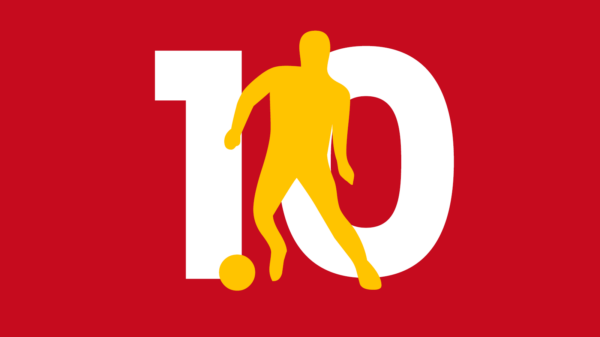Edin Halilović provides a detailed tactical analysis about the La Liga match between Las Palmas and Real Madrid that ended in a draw.

Real Madrid’s weekend visit to the Canary Islands was seen as a potential banana skin for the European champions given Las Palmas’ impressive start to the season and so it proved as they were held to a draw in the league for the second time in less than a week.
Bad spatial occupations create build-up problems
One of the biggest issues both teams had in this game was in their build-up play from the back. Las Palmas, although lined up initially in a 4-2-3-1, often switched to a 3-4-2-1 in the build-up phase during the game with Roque Mesa dropping deep as an auxiliary third centerback to help with bringing the ball out from the back while Garcia and Aythami spread very wide which allowed fullbacks Michel and Castellano to push up.
Although the players at the back were well positioned and set up for the beginning of the build-up play, Mesa dropping into the back three created a void in midfield that wasn’t filled well enough by Viera whose movement towards the ball left too much space in front of him and thus created a big disconnect between the midfield and the front three of Tana, Momo, and Livaja. This, along with Real’s players closing the central passing lanes through organized spatial occupation, limited Las Palmas’ chances of progressing their build-up plays through the middle and instead forced them to either distribute the ball wide or long from the back and didn’t allow them to play their usual short passing game as a result.

Real’s problems in the build-up phase were different. While they did similarly suffer with the poor spacing of the central midfielders, the biggest issue and reason for this for Los Blancos was the deep positioning of centerbacks Varane and Ramos who were far too withdrawn from the players in front of them. This lack of clarity and fluency in Real’s structure created a problem for the progression of their build-up plays which had to come down to Kroos and Modric having to drop deeper themselves, ending up much further away from the front four who spent most of the game in advanced positions, and didn’t allow them to control or impact the game in an offensive sense as much as they’d have liked.

Carvajal and Nacho are positioned near the halfway line while Varane and Ramos are closer to their goalkeeper than they are to the pair of fullbacks, which creates a structural issue and makes it difficult for Real to put any meaningful passing sequences together with the distances between the players being as big as it is. Consequentially, Modric and Kroos not only had to carry the bulk of the build-up play themselves, they also often had to attempt riskier vertical and diagonal passes to the players further forward because of the poor spacing, which played into Las Palmas’ hands defensively better than a quick, short passing game on Real’s part would have.

Las Palmas didn’t really put forth the effort to try and pressurize Real’s back line but instead crowded the middle of the park with bodies in between Real players in an attempt to close down any viable passing options. Because of that, Real’s problems in the build-up play didn’t become apparent until they reached the middle third of the pitch where not only bad spatial occupation of the players affected the facilitation of their passing game negatively, but poor communication and conceptions of misjudgment in regards to who and how they’ll progress their build-up into a more advanced area on the pitch.

Las Palmas didn’t often have such problems in regards to the positioning of their defensive line, but the disorganization of their midfield was all too apparent with Mesa continuously dropping deeper and being the main ball carrier from the back. Gomez and Viera unconvincingly filled the spaces in between the lines and left basic holes in the midfield at times with their lack of separation, which hurt the team’s passing game and rendered the central zone as an inactive source for them to create their attacks in due to the instability of their midfield structure.
Block defending and structural issues lead to poor ball circulation
Another common trait among both teams was the implementation of a central focused, compact defensive block as they often formed multiple man defensive chains to try and disrupt one another’s attacks and win the ball back in attempts to initiate fast paced counters, which was a reference point for both sides’ offensive strategies in this game.
While the teams had their problems in possession, they didn’t have as many on the defensive side of things and displayed a better sense of unity and well drilled organization by staying compact and shutting down the central avenues which only made their tasks of playing through one another even harder than it already was due to their structural and spacing problems.

Las Palmas often switched to a 4-5-1 formation when not in possession and formed a staggered midfield five with the purpose not only being to make themselves difficult to penetrate for the ball carrier in front of them, but also to track the movement of the opposing offensive players well and close down any available passing lanes to force the player on the ball into facilitating risky passes and increase the chances of winning the ball back for themselves and create chances of their own on the break.

This strategy, especially when deployed higher up the pitch when Real are in the first phase of their build-up play, often pinned the away side back and forced Madrid to circulate the ball into a wide position or backwards and allow Las Palmas an opportunity to win the ball back quickly by forcing Real into mistakes or force them to start all over again in their attempts to progress the ball forward successfully.

Real Madrid, on the other hand, shifted to a 4-4-2 or 4-2-4 formation when not in possession and used a mix of defending in a compact, defensive block in numbers with some passing lane-oriented pressing, although this was mainly attempted further up the pitch where their chances of winning the ball back were higher than they were in their defensive third.

Real also occasionally created three-man defensive chains to try and tussle the ball away from Las Palmas in their defensive third which they managed to do successfully half the time by taking advantage of the Canarians’ disorganized midfield structure and poor spatial occupation. Las Palmas tried to counter this with three-man chains of their own by shifting to a 4-3-3 in possession on several occasions, but due to the fragments and major disconnects between each parts of the team, they didn’t find much success offensively or break through Real’s midfield in this manner.
Wide-focused and dangerous transitional attacks
As a result of the poor spatial occupations displayed on both ends, the teams largely focused their efforts on creating opportunities through quick circulation to players in wide positions and through the use of inward diagonal ball movement in the final third. This kind of direct approach requires fast players who are comfortable with the ball at their feet for it to work but that’s exactly what these two sides possess with the likes of Ronaldo, Bale, Momo, and Viera on the pitch at once.
Therefore, it comes as no surprise that both teams found relative success going forward in this game by playing that way and that most of the forward thinking passes for both Las Palmas and Real Madrid were sprayed out into wide areas where they were both looking to double up on with the attack minded fullbacks joining the aforementioned wingers in as many opportunities as they could to create numerical offensive situations in their favor.

Second Half and Conclusion
Quique Setien noticed the problems his team was having in the center of the pitch and struggling to do much of note from an offensive standpoint through the middle and brought on El Zhar and Araujo for Viera and Momo in the second half. This allowed him to switch to more of a direct 4-4-2 formation and focus on hurting Real through the wide areas while with the introduction of another forward in Araujo also had an extra presence up top to occupy Varane and Ramos and create more headaches for the Real defense as the game wore on.
Ultimately, Las Palmas’ pressure told and it paid off with Araujo scoring a late equalizer by taking advantage of some poor Real defending and earning the home team a well earned point. The draw continues their good start to the season while back to back draws for Real mean it’s back to the drawing board for Zidane and his troops as Barcelona and Atletico collected wins at the weekend to etch their way to the Merengues at the top of La Liga.
Read all our Tactical Analyses here.
- Tactical Analysis: Athletic Bilbao 2-2 Atletico Madrid | All square at San Mames - February 3, 2017
- Scout Report: Gabriel Jesus | Manchester City’s new Brazilian starlet - January 5, 2017
- Tactical Analysis: Bayern Munich 1-1 Hoffenheim | Sinsheim club remain unbeaten - November 15, 2016


























































